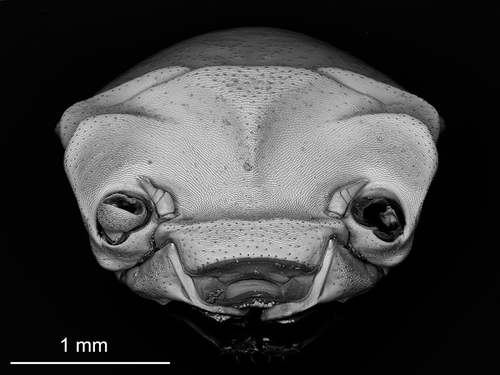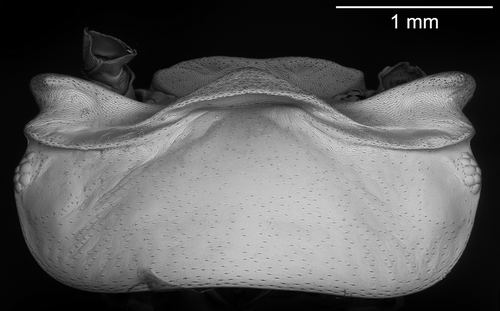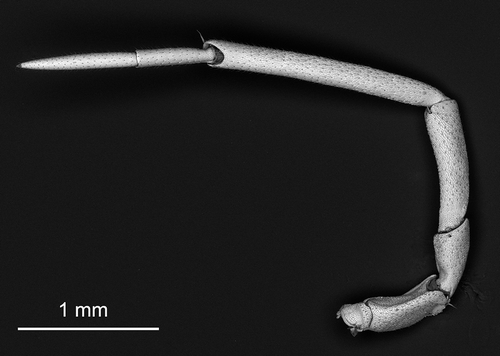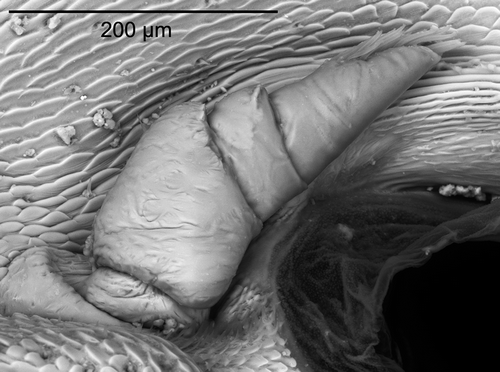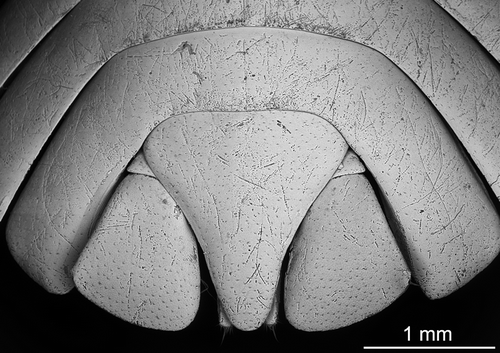Abstract
We describe and illustrate a new species of Armadillidium from Sicily, A. virgo n. sp., collected in two small caves in the Climiti Mountains on the Iblean Plateau (southeastern Sicily, Italy). Of the ∼200 specimens collected thus far, all are females. We compared this putative new species to A. aelleni Caruso & Ferrara found in some Maltese caves, and they seem to be closely related.
Introduction
The first reports on Isopoda from caves of Sicily are those of Brian (Citation1959) and Vandel (Citation1969). Subsequently, surveys began many years ago to study the cave fauna of Sicily and surrounding islands (Brisolese & Caruso Citation1974; Caruso & Brisolese Citation1974; Caruso & Lombardo Citation1977; Caruso Citation1978; Caruso & Costa Citation1978; Caruso & Ferrara Citation1982; Caruso & Hili Citation1991; Lombardo et al. Citation2002). Recently, a rich population of a species of Armadillidium, consisting of females only, was found in two small caves in the Climiti Mountains (Syracuse, Italy) in southeastern Sicily. Because we were unable to ascribe this population to any known species of Armadillidium, we propose here that it is a new species and possibly parthenogenetic.
Materials and methods
All specimens have been collected in small karstic caves, which can be inspected to about 12 m, although they extend deeper as narrow holes. The average temperature is 18.1°C, and the relative humidity ranges between 75 and 100%. The caves are located in a valley carved in Oligo-Miocene carbonate succession (D'Urso & Grasso Citation2009).
Numerous samples were collected by hand almost monthly in 2007 and 2008 (as shown by the collection dates) with the goal of finding both females and males; however, no males have ever been found. Pitfall traps, filled with a saturated solution of NaCl and water with no bait, were also placed in one of the caves. To avoid over-catching, we emptied the traps every third day, but males were never found. We checked the sex of all specimens: some were then stored in 70% ethanol; others, intended for use in molecular studies of population genetic variability, were stored at –80°C; and others were reared to allow study of their reproductive biology.
Morphological observation was conducted both with a stereomicroscope (Zeiss STEMI SV8) and a scanning electron microscope (SEM VEGA II LMU).
The holotype and paratypes are deposited in the collection of D. Caruso at the Department of Animal Biology, University of Catania (Italy).
Results
Armadillidium virgo n. sp.
Specimen collection
We collected specimens of the proposed Armadillidium virgo n. sp. from two caves throughout the two collection years. One location was Grotta Di Natale, Morghella (Municipality of Priolo-Gargallo), Province of Syracuse, Sicily; its geographical references are WGS84 N 37˚07'03' E 15˚08'36'. Collection dates and numbers for this location were as follows.
Holotype: January 2007, 1 female, R. Grasso leg.
Paratypes: January 2007, 15 females, R. Grasso leg.; February 2007, 24 females; March 2007, 18 females; April 2007, 20 females; May 2007, 15 females; June 2007, 10 females; September 2007, 1 female; October 2007, 2 females; November 2007, 4 females; December 2007, 6 females; January 2008, 10 females; February 2008, 10 females; April 2008, 15 females; May 2008, 3 females; October 2008, 4 females; and December 2008, 7 females, 3 juv., D. Caruso & R. Grasso leg.
The second location was also in Sicily, at Cave No. 2, about 200 m north of Grotta Di Natale. Collection dates and numbers for this location were as follows: January 2007, 6 females; February 2007, 6 females; March 2007, 15 females; May 2007, 2 females; November 2007, 1 female; January 2008, 1 female; and December 2008, 2 females.
Description
Of the collected specimens, the biggest females are 18 × 8 mm (). The body, strongly depigmented, appears pale yellow, and the intestinal apparatus can be dimly seen because of the transparency. The dorsal surface is smooth and shiny. The eyes are reduced and consist of 3–8 strongly depigmented ommatidia. The cephalon has a raised frontal shield with a superior margin that appears straight in frontal view (); between it and the vertex, a well-marked long slit is observable (). The margin of the frontal shield continues in the antennal furrows, which are long but not very deep. The antennal lobes are trapezium-shaped, thick, and bent slightly backwards. Antennae are long and frail; bent backwards, they reach beyond the half pereion segment 3; the second segment of flagellum is longer than the first () and is covered with several aesthetascs, arranged as shown in .
Figure 1. Armadillidium virgo n. sp., female. A, dorsal view; B, cephalon and pereionite 1. Scale bar: 9 mm.
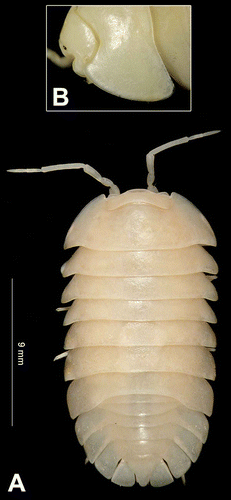
Figure 5. Armadillidium virgo n. sp., detail of the flagellum segment 2, showing aesthetascs. Scale bar: 200 µm.
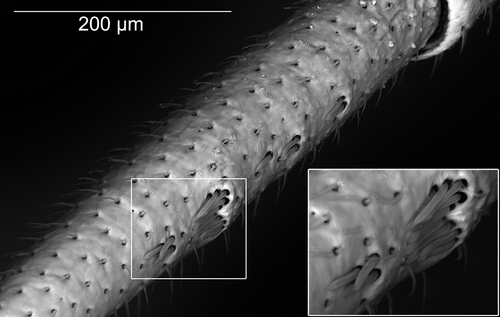
The antennulae have three segments: the second segment carries a small thorn-shaped extension, and the third has several aesthetascs from its mid-part to the tip (). The anterior margin of the first pereionite slightly, but clearly projects forward and bends upwards; the posterior margin at the base of the epimera appears concave, with rounded angles (). The epimera of the pereion slant downwards. The pleon epimera are in the same line with the exopodite margins of the uropods; the latter are large and flat and with some setae on the external margin. Endopodites are small, not easily seen in dorsal view, cylinder-shaped, and as long as the telson. The telson is triangular with slightly concave margins and a rounded tip ().
Discussion
This proposed new species shows marked adaptations to cave-dwelling in those structures typically modified in species that have become troglobious: long, thin, frail legs, eyes with few ommatidia, and marked loss of pigmentation, all suggesting at least a troglophile classification. No specimen has been found outside of the caves, even after thorough searching, although specimens reach 18 mm and therefore would be easily seen.
Sampling was repeated almost monthly for two years to test for the presence of males; however, only females were ever collected. To test the hypothesis of a sex inversion during growth, we reared many specimens, checking them weekly: all observed specimens moulted regularly and maintained female sex. In some females, the marsupium formed and eggs were laid, which, however, often regressed. The single female that completed its pregnancy brought forth eight pulli, of which six have become adults; all of them are females.
Parthenogenesis is not widespread in Isopoda: Oniscidea. Species that are undoubtedly parthenogenetic are Platyarthrus aiasensis (Caruso Citation1968a,b), Trichoniscus pusillus (Legrand & Juchault Citation2006), Ocelloscia floridiana (Johnson Citation1986), Nagurus cristatus (Radu Citation1962 sub. Bifrontonia feminina), and Nagurus modestus Dollf. (Hill Citation1948 sub. Nagara modesta). This form of reproduction has not been reported thus far for any species of Armadillidium, only a few species of which live in caves. One of these is A. tabacarui (Gruia et al. Citation1994), reported from caves of Romania; this troglobious and consequently unpigmented species, however, is not parthenogenetic, nor is it morphologically close to A. virgo.
To assess the possible parthenogenetic reproduction of this species, in addition to studying its life cycle, we have started research aimed at evaluating the population genetic variability because, as is well known, it has very low levels in parthenogenetic populations (Cordaux et al. Citation2004). Moreover, in the laboratory of one author (Bouchon), further investigation has begun aimed at monitoring the possible parasitic presence in this population of Wolbachia, bacteria that can cause anomalies in host sex (Michel-Salzat et al. Citation2001) and induce parthenogenesis as a consequence. In the meantime, the field research on the quest for males continues.
Derivatio nominis
The specific epithet refers to the possible parthenogenetic habitus of the new species.
Relationship
The new species is similar to Armadillidium aelleni Caruso & Ferrara, endemic to caves of the Maltese Archipelago. The two species are easily distinguished because in A. aelleni, the pereion epimera point outwards almost horizontally, giving the body a much more flattened aspect than in the new species, which exhibits a much less evident trend. Moreover, the cephalons differ mainly in the morphology of the frontal shield and the antennal lobes and furrows.
The presence in the Climiti Mountains of this new species that is probably related to A. aelleni of the Maltese Archipelago would be further evidence of the existence of an Iblean–Maltese territory, as already proposed by Caruso and Lombardo (Citation1982).
Acknowledgements
We gratefully thank Dr Rosario Grasso, who first collected many specimens of this species; Dr Toni Puma for image expertise at the stereomicroscope; and Dr Alfio Viola for his kind collaboration in taking SEM photos. We also give special thanks to Dr Giuseppe Montesanto for his support, advice, and patience in improving this paper.
References
- Brian , A . 1959 . Nota su tre Trichoniscidi provenienti da caverne della Sicilia raccolti dal Sig . G. Mannino con descrizione di un nuovo genere. Studia spelaeologica , 4 : 95 – 100 .
- Brisolese , S and Caruso , D . 1974 . Ricerche bio-ecologiche sulla fauna delle grotte di Sicilia . II. Nesiotoniscus helenae nuova specie di isopodo cavernicolo di Sicilia. Animalia (Catania) , 1 : 257 – 264 .
- Caruso , D . 1968a . Osservazioni sulla partenogenesi e sullo sviluppo postembrionale in Platyarthrus aiasensis (Crustacea, Isopoda) . Bollettino di Zoologia , 35 : 425
- Caruso , D . 1968b . Partenogenesi e spanandria in Platyarthrus aiasensis Legrand (Crustacea, Isopoda) . Bollettino delle sedute dell'Accademia Gioenia di Scienze Naturali in Catania, Serie IV , 9 : 451 – 457 .
- Caruso , D . 1978 . Ricerche faunistiche ed ecologiche sulle grotte di Sicilia . V. Isopodi nuovi di grotte carsiche siciliane (Crustacea, Isopoda, Oniscoidea). Animalia (Catania) , 5 : 145 – 157 .
- Caruso , D and Brisolese , S . 1974 . Ricerche bio-ecologiche sulla fauna delle grotte di Sicilia . I. Isopodi terrestri delle grotte vulcaniche dell'Etna. Animalia (Catania) , 1 : 123 – 133 .
- Caruso , D and Costa , G . 1978 . Ricerche faunistiche ed ecologiche sulle grotte di Sicilia . VI. Fauna Cavernicola di Sicilia (Catalogo ragionato). Animalia (Catania) , 5 : 423 – 523 .
- Caruso , D and Ferrara , F . 1982 . Armadillidium aelleni new species of terrestrial isopod from a cave on Malta . Revue suisse de Zoologie , 89 : 809 – 814 .
- Caruso , D and Hili , C . 1991 . Nuovi dati sugli isopodi terrestri delle isole dell'Arcipelago Maltese . Animalia (Catania) , 18 : 115 – 124 .
- Caruso , D and Lombardo , BM . 1977 . Ricerche faunistiche ed ecologiche sulle grotte di Sicilia . III. Spelaeoniscus ragonesei nuova specie di isopodo di una grotta dei Monti Iblei (Sicilia) (Crustacea, Isopoda, Oniscoidea). Animalia (Catania) , 4 : 99 – 107 .
- Caruso , D and Lombardo , BM . 1982 . Isopodi terrestri delle Isole Maltesi . Animalia (Catania) , 9 : 5 – 52 .
- Cordaux , R , Michel-Salzat , A , Frelon-Raimond , M , Rigaud , T and Bouchon , D . 2004 . Evidence for a new feminizing Wolbachia strain in the isopod Armadillidium vulgare: Evolutionary implications . Heredity , 93 : 78 – 84 .
- D'Urso , V and Grasso , R . 2009 . First record of troglobitic Fulgoromorpha from Italy (Hemiptera, Auchenorrhyncha, Cixiidae) . Deutsche Entomologische Zeitschrift , 56 : 7 – 14 .
- Gruia , M , Iavorschi , V and Sarbu , S . 1994 . Armadillidium tabacarui (Isopoda: Oniscidea: Armadillidiidae), a new troglobitic species from a sulfurous cave in Romania . Proceedings of the Biological Society of Washington , 107 : 699 – 706 .
- Hill , R . 1948 . Parthenogenesis bei Nagara modesta Dollf. ( . Isopodae. Chromosoma , 3 : 232 – 256 .
- Johnson , C . 1986 . Parthenogenetic reproduction in the philosciid isopod, Ocelloscia floridiana (Van Name, 1940) . Crustaceana , 51 : 123 – 132 .
- Legrand , JJ and Juchault , P . 2006 . “ The ontogeny of sex and sexual physiology ” . In The Crustacea , Edited by: Forest , J and von Vaupel Klein , JC . 353 – 460 . Leiden : Brill Academic Publishers .
- Lombardo , BM , Viglianisi , F and Caruso , D . 2002 . Genetic and morphological differentiation in some populations of Armadillidium aelleni (Crustacea, Isopoda, Oniscidea), a cavernicolous species of the Maltese archipelago . Italian Journal of Zoology , 69 : 381 – 384 .
- Michel-Salzat , A , Cordaux , R and Bouchon , D . 2001 . Wolbachia diversity in the Porcellionides pruinosus complex of species (Crustacea, Oniscidea): Evidence for host-dependent patterns of infection . Heredity , 87 : 428 – 434 .
- Radu , VG . 1962 . Partenogeneza la Bifrontonia feminina Radu (izopod terestru) . Studii şi Cercetari de Biologie, Academia Republicii populare romine, Filiala Cluj , 13 : 259 – 271 .
- Vandel , A . 1969 . Les Isopodes terrestres de la Sicile . Atti Accademia Gioenia di Scienze Naturali Catania, VII , 1 : 1 – 59 .
